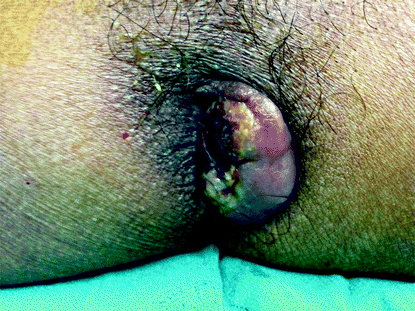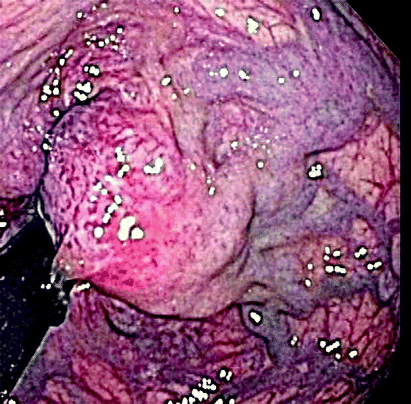Fig. 10.1
Perianal abscess. © Dale Dangleben, MD
Hemorrhoids
Hemorrhoids can be diagnosed by a thorough history and physical examination. The examination should include inspection while straining. In all patients who present with rectal bleeding, an anoscopy and proctosigmoidoscopy should be part of the initial evaluation (Fig. 10.2). A colonoscopy or a barium enema must be performed if the source of bleeding is not identified and in order to rule out malignancy (Fig. 10.3).



Fig. 10.2
Thrombosed hemorrhoid with necrotic area. © Dale Dangleben, MD

Fig. 10.3
Endoscopic view (retroflex) of internal hemorrhoid. © Dale Dangleben, MD
Anal Fissures
The diagnosis of an anal fissure can be obtained by history and physical examination. A typical history includes pain and bleeding with defecation in the setting of prior constipation. The diagnosis is confirmed by gently parting the buttocks and inspection. More invasive examination such as digital examination should be deferred as it is often not tolerated in acute cases. Endoscopic examination should be performed, but this can be delayed 4–6 weeks until the pain is resolved.
Complications
Perirectal Abscesses
The majority of complications that arise from perirectal abscesses result secondary to improper, or incomplete, drainage. One of the most common complications of perirectal abscesses is anal fistula which occurs in about 50% of drained anorectal abscesses. In cases where circumferential spread occurs, a horseshoe abscess may result.
Improperly treated perirectal abscesses can lead to severe sepsis, which may prove to be life threatening in the immunocompromised. Necrotizing soft tissue infection of the perineum is a rare but lethal condition. Recurrence is also common in cases of inadequate drainage and fistulas.
Stay updated, free articles. Join our Telegram channel

Full access? Get Clinical Tree








